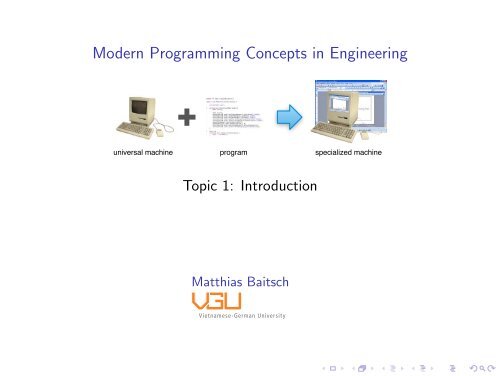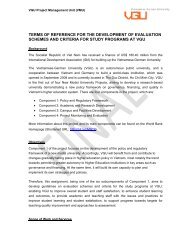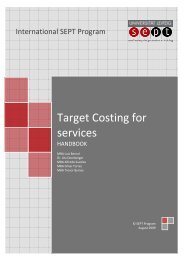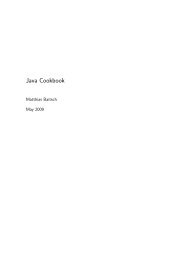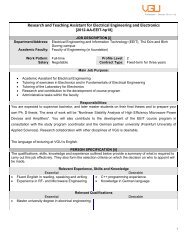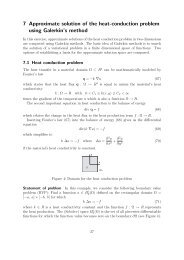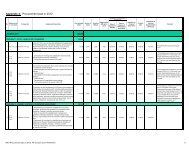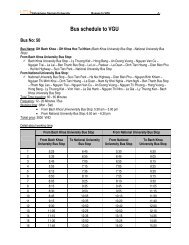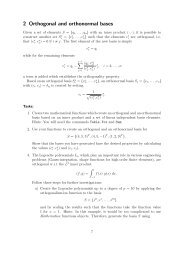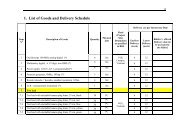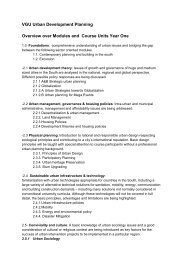Modern Programming Concepts in Engineering - Vietnamese ...
Modern Programming Concepts in Engineering - Vietnamese ...
Modern Programming Concepts in Engineering - Vietnamese ...
Create successful ePaper yourself
Turn your PDF publications into a flip-book with our unique Google optimized e-Paper software.
<strong>Modern</strong> <strong>Programm<strong>in</strong>g</strong> <strong>Concepts</strong> <strong>in</strong> Eng<strong>in</strong>eer<strong>in</strong>g<br />
universal mach<strong>in</strong>e program specialized mach<strong>in</strong>e<br />
Topic 1: Introduction<br />
Matthias Baitsch<br />
<strong>Vietnamese</strong>-German University
About the course. . .
Goals of the course<br />
After successfully complet<strong>in</strong>g this course, you will<br />
◮ know the key concepts of object-oriented programm<strong>in</strong>g<br />
◮ master a programm<strong>in</strong>g language: Java<br />
◮ be able to tackle many different programm<strong>in</strong>g problems <strong>in</strong><br />
eng<strong>in</strong>eer<strong>in</strong>g sciences<br />
◮ know about types of algorithms and you will be able to<br />
implement them<br />
◮ know a variety of data structures and you will choose the right<br />
one for your problem at hand<br />
◮ build your own software upon exist<strong>in</strong>g libraries
What other students programmed after one semester Java<br />
Simulation of a nonl<strong>in</strong>ear pendulum<br />
Start application: Mac OS X/W<strong>in</strong>dows
We use an exist<strong>in</strong>g software package: view3D<br />
What is the “view3D” package?<br />
◮ Java library for <strong>in</strong>teractive 3D graphics<br />
◮ Based on freely available Visualization Toolkit (VTK)<br />
◮ Developed at the Institute for Computational Eng<strong>in</strong>eer<strong>in</strong>g
Learn<strong>in</strong>g approach: Outside-<strong>in</strong><br />
What does outside-<strong>in</strong> mean?<br />
You start as consumer of software and you will become a producer<br />
of software later on. We will start with the view3D package.<br />
Us<strong>in</strong>g the view3D library, you<br />
◮ build three-dimensional models easily<br />
◮ create <strong>in</strong>terest<strong>in</strong>g programs from the first day on<br />
◮ learn from exist<strong>in</strong>g software which serves as model and<br />
<strong>in</strong>spiration<br />
◮ become familiar to the use of software through abstract<br />
<strong>in</strong>terfaces
Why modern programm<strong>in</strong>g concepts <strong>in</strong> eng<strong>in</strong>eer<strong>in</strong>g?
Why modern programm<strong>in</strong>g concepts <strong>in</strong> eng<strong>in</strong>eer<strong>in</strong>g?<br />
1. Comput<strong>in</strong>g is pervasive <strong>in</strong> eng<strong>in</strong>eer<strong>in</strong>g:<br />
◮ Numerical simulations<br />
◮ Optimization of structures and processes<br />
◮ Computer aided design<br />
◮ Environmental model<strong>in</strong>g<br />
◮ Construction management<br />
◮ Data management<br />
Advances <strong>in</strong> eng<strong>in</strong>eer<strong>in</strong>g depend on advances <strong>in</strong> comput<strong>in</strong>g
Why modern programm<strong>in</strong>g concepts <strong>in</strong> eng<strong>in</strong>eer<strong>in</strong>g?<br />
2. Eng<strong>in</strong>eer<strong>in</strong>g problems become:<br />
◮ Bigger (<strong>in</strong> terms of simulation model size)<br />
◮ More complicated (coupled fields, probability, . . . )<br />
◮ Multidiscipl<strong>in</strong>ary (take <strong>in</strong>to account eng<strong>in</strong>eer<strong>in</strong>g aspects,<br />
economics, energy management, . . . )<br />
Industry demands for software solutions
Why modern programm<strong>in</strong>g concepts <strong>in</strong> eng<strong>in</strong>eer<strong>in</strong>g?<br />
In order to cope with current and future challenges, creators of<br />
eng<strong>in</strong>eer<strong>in</strong>g software have to<br />
◮ employ efficient solution procedures (numerical methods)<br />
◮ exploit modern computer hardware (parallel comput<strong>in</strong>g)<br />
◮ use the Internet (distributed and grid comput<strong>in</strong>g)<br />
◮ establish <strong>in</strong>teractive simulation models (computational<br />
steer<strong>in</strong>g, virtual reality)<br />
◮ provide comprehensible evaluation methods (visualization)<br />
◮ ensure correctness of results (as far as possible)<br />
Problems can not be solved simply by trial and error, rather a rich<br />
set of methods and concepts is required
What are modern programm<strong>in</strong>g concepts <strong>in</strong> eng<strong>in</strong>eer<strong>in</strong>g?<br />
Most important methods and concepts:<br />
◮ Object-oriented programm<strong>in</strong>g (OOP)<br />
◮ Formal model<strong>in</strong>g techniques (Unified Model<strong>in</strong>g Language)<br />
◮ Use of exist<strong>in</strong>g software packages, frameworks and services<br />
◮ Automated test<strong>in</strong>g and test driven development<br />
◮ <strong>Modern</strong> user <strong>in</strong>terfaces and <strong>in</strong>teractive visualization<br />
→ Choice of methods and concepts depend on software project
Why object-oriented programm<strong>in</strong>g (OOP)?<br />
Short answer<br />
Because object-oriented programm<strong>in</strong>g works!
Why object-oriented programm<strong>in</strong>g (OOP)?<br />
Short answer<br />
Because object-oriented programm<strong>in</strong>g works!<br />
Long answer<br />
Because object-oriented programm<strong>in</strong>g<br />
◮ provides a natural and powerful way to model actual<br />
(eng<strong>in</strong>eer<strong>in</strong>g) problems<br />
◮ simplifies the development of software which is extensible and<br />
ma<strong>in</strong>ta<strong>in</strong>able<br />
◮ lets developers split software up <strong>in</strong>to separate, reusable parts<br />
◮ helps developers to build reliable software systems<br />
◮ simplifies programm<strong>in</strong>g <strong>in</strong> a team of programmers<br />
→ OOP helps to keep complex software systems manageable
Choos<strong>in</strong>g a programm<strong>in</strong>g language for MPCE<br />
We use Java because Java is<br />
◮ strictly object-oriented<br />
◮ comparatively easy to learn<br />
◮ a modern programm<strong>in</strong>g language<br />
◮ supported by various freely available development<br />
environments<br />
◮ platform <strong>in</strong>dependent and programs are portable<br />
We do we not use<br />
◮ Fortran: Not object oriented, limited to numerics<br />
◮ C++: Widely used and powerful but hard to learn<br />
◮ C#: Would be an alternative but proprietary<br />
◮ Visual Basic: Not suitable for numerical computations<br />
Languages <strong>in</strong> green: Widely used <strong>in</strong> eng<strong>in</strong>eer<strong>in</strong>g
The Java Virtual Mach<strong>in</strong>e<br />
Compiled language<br />
Java VM<br />
hello.cpp<br />
Source code<br />
hello.java<br />
Source code<br />
C++ compiler<br />
Java compiler<br />
Byte code<br />
Virtual mach<strong>in</strong>e<br />
hello.exe<br />
Executable<br />
hello.class<br />
java.exe<br />
◮ Compiler generates mach<strong>in</strong>e<br />
code<br />
◮ Mach<strong>in</strong>e code is directly<br />
executed by CPU<br />
◮ Compiler generates byte<br />
code<br />
◮ Byte code is executed by<br />
virtual mach<strong>in</strong>e a which is<br />
executed by CPU<br />
a Often, VMs are implemented <strong>in</strong> C
The Java Virtual Mach<strong>in</strong>e<br />
Advantages of us<strong>in</strong>g a Virtual Mach<strong>in</strong>e<br />
◮ VM manages memory (garbage collection)<br />
◮ VM performs extensive runtime error check<strong>in</strong>g<br />
◮ VM handles access to system resources (memory etc.)<br />
◮ A Java program can run on any platform where a virtual<br />
mach<strong>in</strong>e is available<br />
Simplifies the development of portable, secure and reliable<br />
software!<br />
Disadvantages<br />
◮ Impact on execution speed<br />
◮ Java needs to be <strong>in</strong>stalled on the target computer
Summary<br />
<strong>Modern</strong> <strong>Programm<strong>in</strong>g</strong> <strong>Concepts</strong> <strong>in</strong> Eng<strong>in</strong>eer<strong>in</strong>g<br />
◮ covers theory and practice of object-oriented programm<strong>in</strong>g<br />
◮ uses Java as a programm<strong>in</strong>g language, but concepts can be<br />
transferred easily to other languages<br />
◮ covers fundamental data structures, how they work and how<br />
to make use of them<br />
◮ <strong>in</strong>troduces basic algorithms from the field of eng<strong>in</strong>eer<strong>in</strong>g, both<br />
theoretically (complexity) as well as practically (through<br />
examples)
<strong>Programm<strong>in</strong>g</strong> computers
Computers<br />
Blue Gene at Sandia national labs L<strong>in</strong>ux cluster Bochum Laptop computer Mobile phone<br />
Computers are<br />
◮ com<strong>in</strong>g <strong>in</strong> very different flavours<br />
◮ becom<strong>in</strong>g faster and more powerful<br />
◮ nowadays everywhere<br />
◮ present <strong>in</strong> nearly every aspect of daily life<br />
Computers are universal mach<strong>in</strong>es execut<strong>in</strong>g programs
What do the components of a computers do?<br />
Outside world<br />
Computer<br />
- Humans<br />
- Other computers<br />
- Devices<br />
- Environment<br />
Communication<br />
devices<br />
Monitor<br />
Keyboard/Mouse<br />
Processors<br />
Memories<br />
Network device<br />
Sensor<br />
Processors carry out <strong>in</strong>structions, send and receive data from<br />
communication devices, store and retrieve data and<br />
programs from memories<br />
Memories store program and data, persistent or temporary<br />
Communication devices connect the computer to the outside<br />
world, present and gather data<br />
Processors are <strong>in</strong>structed by the program they execute
What is a program?
What is a program?<br />
Examples. . .
Interactive program with graphical user <strong>in</strong>terface<br />
Interactive programs<br />
◮ are started by users by click<strong>in</strong>g an icon<br />
◮ send and receive data from devices such as monitor, pr<strong>in</strong>ter,<br />
network card, speakers, hard disk drive<br />
◮ react on user <strong>in</strong>put from mouse and keyboard
Console program<br />
Console programs<br />
◮ are started by users by typ<strong>in</strong>g a command<br />
◮ typically do not require user <strong>in</strong>put dur<strong>in</strong>g execution<br />
◮ most often store results of computation on the hard disk<br />
◮ are common <strong>in</strong> scientific and high-performance comput<strong>in</strong>g
Program runn<strong>in</strong>g on a server computer<br />
User's computer (yours)<br />
Server computer<br />
http request<br />
Web server<br />
(e.g. apache)<br />
html document<br />
Web browser<br />
Server programs<br />
◮ are started automatically when the computer starts up<br />
◮ run for weeks or months<br />
◮ usually do not require any user <strong>in</strong>teraction<br />
◮ <strong>in</strong>teract with other programs runn<strong>in</strong>g on another computer
Programs turn computers <strong>in</strong>to specialized mach<strong>in</strong>es<br />
universal mach<strong>in</strong>e program specialized mach<strong>in</strong>e<br />
A computer is a universal mach<strong>in</strong>e. When you feed it with a<br />
program, it becomes a specialized mach<strong>in</strong>e which can be used to<br />
carry out a specific task.<br />
Examples:<br />
◮ Start Word – Your computer becomes a mach<strong>in</strong>e for writ<strong>in</strong>g a<br />
letter (for your thesis, you might use someth<strong>in</strong>g else)<br />
◮ Start Ansys – Your computer becomes a mach<strong>in</strong>e for<br />
structural analysis
Program execution<br />
Data<br />
Flow<br />
Monitor<br />
Program<br />
Start of program execution<br />
Keyboard/Mouse<br />
Network device<br />
Sensor<br />
process<strong>in</strong>g<br />
Persistent storage<br />
(HDD)<br />
A program<br />
Program term<strong>in</strong>ation<br />
◮ has a well-def<strong>in</strong>ed entry po<strong>in</strong>t where program execution starts<br />
◮ receives <strong>in</strong>put from communication devices<br />
◮ sends data to communication devices<br />
◮ reads and writes data to persistent storage devices<br />
◮ has one or more conditions which term<strong>in</strong>ate program execution<br />
An execut<strong>in</strong>g program is an immaterial mach<strong>in</strong>e
Build<strong>in</strong>g and runn<strong>in</strong>g programs<br />
A programmer<br />
writes a<br />
which<br />
Program<br />
a user<br />
runs on<br />
a computer
Build<strong>in</strong>g and runn<strong>in</strong>g programs<br />
A programmer<br />
us<strong>in</strong>g<br />
a computer<br />
writes a<br />
which<br />
Program<br />
a user<br />
runs on<br />
a computer
Build<strong>in</strong>g and runn<strong>in</strong>g programs<br />
A programmer<br />
us<strong>in</strong>g<br />
a computer<br />
writes a<br />
which<br />
Program<br />
run on<br />
users<br />
their computers
Build<strong>in</strong>g and runn<strong>in</strong>g programs<br />
programmers<br />
us<strong>in</strong>g<br />
computers<br />
write a<br />
which<br />
Program<br />
run on<br />
users<br />
their computers
What makes a program a good program?<br />
A good program is<br />
correct: It does what it’s supposed to. This sounds trivial but<br />
do you know any program which never crashes?<br />
extensible: It is easy to change and to add new functionality<br />
readable: The program source code is understandable to<br />
humans!<br />
reusable: Parts of the program can be used later to build other<br />
programs (prevent re<strong>in</strong>vention of the wheel)<br />
robust: It reacts appropriately to errors<br />
secure: It does not let others misuse your computer
Writ<strong>in</strong>g computer programs<br />
Writ<strong>in</strong>g programs it tough:<br />
◮ Programs crash<br />
◮ Programs give wrong results<br />
◮ Gett<strong>in</strong>g a program right can be really hard<br />
→ As a programmer, you are <strong>in</strong> charge
Writ<strong>in</strong>g computer programs<br />
Writ<strong>in</strong>g programs it tough:<br />
◮ Programs crash<br />
◮ Programs give wrong results<br />
◮ Gett<strong>in</strong>g a program right can be really hard<br />
→ As a programmer, you are <strong>in</strong> charge<br />
Writ<strong>in</strong>g programs is fun:<br />
◮ Design and build your own mach<strong>in</strong>es<br />
◮ Exert your creativity and imag<strong>in</strong>ation<br />
◮ Hav<strong>in</strong>g created a runn<strong>in</strong>g program is a good feel<strong>in</strong>g<br />
→ There are (nearly) no limits, what you can do
A first example. . .
A first example: Elastic pendulum<br />
Elements:<br />
- circular section d = 0.1<br />
Material:<br />
- E = 500000 N/m², ρ = 10 kg/m³<br />
Node at (0.0, 2.5)<br />
Node at (2.5, 2.5)<br />
Node at (0, 0)<br />
y<br />
x<br />
Constra<strong>in</strong>t<br />
g = 9.81 m/s²<br />
Next slide: Use exist<strong>in</strong>g Java package (m<strong>in</strong>iFE – developed <strong>in</strong><br />
Bochum) <strong>in</strong> order to create a f<strong>in</strong>ite-element model of the system<br />
and to perform a nonl<strong>in</strong>ear transient analysis simulat<strong>in</strong>g 20 seconds<br />
us<strong>in</strong>g 2000 timesteps.
import i n f . m i n i f e . f e . Node ;<br />
import i n f . m i n i f e . f e . e l e m e n t s . e1d . Truss2D ;<br />
import i n f . m i n i f e . f e . s c t . C i r c l e S ;<br />
import i n f . m i n i f e . f e . u t i l . A n a l y s i s T y p e s ;<br />
import i n f . m i n i f e . view2 . Viewer2 ;<br />
p u b l i c c l a s s PendulumProgram {<br />
p u b l i c s t a t i c void ma<strong>in</strong> ( S t r i n g [ ] a r g s ) {<br />
Model m = new Model ( ) ;<br />
Node n1 = m. createNode ( 0 . 0 , 0 . 0 ) ;<br />
Node n2 = m. createNode ( 2 . 5 , 2 . 5 ) ;<br />
Node n3 = m. createNode ( 0 . 0 , 2 . 5 ) ;<br />
C o n s t r a i n t c = new C o n s t r a i n t ( f a l s e , f a l s e , true ) ;<br />
M a t e r i a l mat = m. c r e a t e M a t e r i a l ( 5 0 0 0 0 0 . 0 , 1 0 . 0 ) ;<br />
C i r c l e S s c t = m. c r e a t e S e c t i o n ( C i r c l e S . TYPE ) ;<br />
n1 . s e t C o n s t r a i n t ( c ) ;<br />
s c t . s e t D i a m e t e r ( 0 . 1 ) ;<br />
m. c r e a t e E l e m e n t ( Truss2D . TYPE, mat , s ct , n1 , n2 ) ;<br />
m. c r e a t e E l e m e n t ( Truss2D . TYPE, mat , s ct , n2 , n3 ) ;<br />
m. g e t S e t t i n g s ( ) . s e t A c c e l e r a t i o n (DOF. T Y , 9 . 8 1 ) ;<br />
A n a l y s i s T y p e s . n o n l i n e a r T r a n s i e n t (m, 2 0 , 2 0 0 0 , 1 e − 6 , 0 . 7 ) ;
The runn<strong>in</strong>g program
Summary<br />
◮ Today, eng<strong>in</strong>eer<strong>in</strong>g and comput<strong>in</strong>g are closely connected<br />
◮ Computers are universal mach<strong>in</strong>es<br />
◮ Feed<strong>in</strong>g a computer with a program turns the computer <strong>in</strong>to a<br />
specialized mach<strong>in</strong>e<br />
◮ An execut<strong>in</strong>g program is an immaterial mach<strong>in</strong>e<br />
◮ Object-oriented software models can be close to the problem<br />
doma<strong>in</strong><br />
◮ Exist<strong>in</strong>g libraries can provide powerful functionality


